Engaging in Koi fish farming within the Philippines presents a compelling avenue for a lucrative enterprise. The country’s favorable climatic conditions and rich aquatic resources create an ideal environment for these ornamental fish to flourish. In this blog, we delve into the intricacies of Koi fish farming, unveiling its profitability as a business venture.
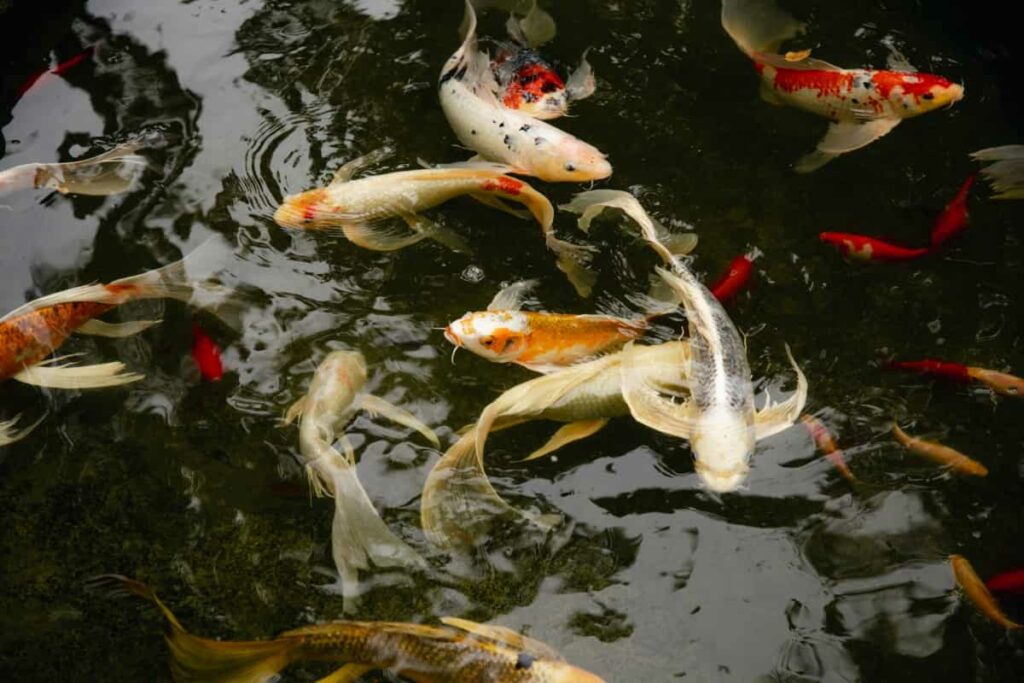
Explore the fusion of traditional aquaculture practices with modern techniques as we navigate the essential steps from breeding to maintenance. Embark on a journey that combines the beauty of nature with the realms of entrepreneurship, all within the realm of Koi fish farming.
What is Koi Fish Farming?
Koi fish farming involves cultivating koi fish, a captivating species, in specialized ornamental ponds. The term “koi” originates from Japanese, denoting “carp.” While carp have held ornamental significance in Asia for centuries, the introduction of Koi to the Western world is more recent.Koi exhibit various colors and patterns, rendering them aesthetically pleasing and serene.
These hardy creatures can thrive for decades under proper care, ranging from a mere two inches to an impressive three feet in length. Beyond their pet popularity, koi fish farming has become a thriving business endeavor. Their appeal extends to both the live market and as potential food sources. The captivating hues of Koi make them particularly coveted by collectors and enthusiasts.
Initiating a successful koi farm necessitates certain prerequisites. The foremost requirement involves constructing or procuring a suitable pond. Adequate space, a minimum of 10 feet in length and six feet in depth, is imperative for the growth and mobility of Koi. To maintain optimal water quality, efficient filtration, and aeration systems are mandatory.
Different Types of Koi Fish
Distinct types of Koi fish exhibit varying color arrangements, notably encompassing red, black, white, and yellow shades. While singularly colored Koi are less frequent, shades like orange, blue, and green exist. Bi-colored and tri-colored variations further diversify the spectrum. The most prized Koi bear intricate body motifs, elevating their worth.
In case you missed it: Profitable Carp Farming in the Philippines: A Step-by-Step Guide for Carp Fish Culture
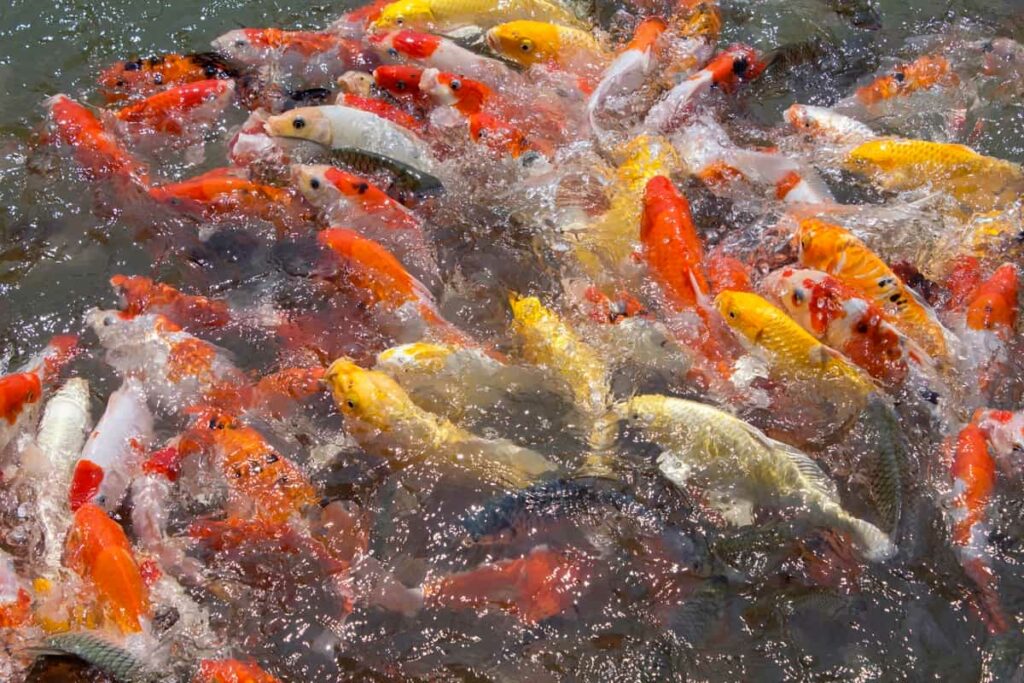
In size, mature Koi average around two feet in length, though some attain three to four feet. Astoundingly, the largest documented Koi extended beyond six feet and weighed over 200 pounds. Koi fish boasts a lifespan of approximately 25 years, with some individuals surpassing this benchmark. The most-aged Koi on record lived for over 200 years, underscoring their remarkable longevity.
Advantages and Drawbacks of Koi Fish Farming
Pros/Advantages
- Profitable Venture: Koi farming holds the potential for substantial profits.
- Simplicity: Establishing and upkeeping a koi fish farm is relatively straightforward.
- Aesthetic Appeal: The allure of koi fish can attract tourists, enhancing your farm’s popularity.
- Longevity: With a lengthy lifespan, koi fish provide lasting enjoyment.
- Low Maintenance: These fish require minimal care, minimizing time and cost investment.
- Water Purification: Koi contributes to water purification, benefiting people and wildlife.
- Therapeutic Value: Koi’s calming effect can positively impact mental well-being.
- Healthy Seafood: Koi farming can yield safe, chemical-free seafood.
Cons/Drawbacks
- Water Quality Impact: Inadequate water quality or low oxygen levels can lead to koi fatalities.
- Pest Attraction: Backyard koi ponds might attract bugs and pests.
- Regular Cleaning: Maintaining koi ponds necessitates consistent cleaning efforts.
- Expense: Building koi ponds can be financially demanding.
- Complex Maintenance: Pond upkeep can involve intricate procedures.
Best Koi Fish Farming Practices in the Philippines
- Pond Preparation: Craft a spacious pond at least 10 feet long and six feet deep. This offers ample room for Koi growth and movement.
- Filtration and Aeration: Install efficient filtration and aeration systems to ensure optimal water quality. This aids in the fish’s well-being.
- Stocking Strategy: Source quality Koi fry from reputable breeders or hatcheries. Introduce them gradually to prevent stress.
- Nutrition Management: Provide a balanced diet, including specialized Koi pellets and occasional treats. This boosts their health and vibrant colors.
- Temperature Control: Maintain water temperature between 65°F- 75°F (18°C-24°C), as Koi are sensitive to extreme temperatures.
- Regular Monitoring: Monitor water parameters, oxygen levels, and fish behavior. Swiftly address any irregularities.
- Disease Prevention: Quarantine new fish to prevent disease transmission. Regularly inspect and treat for parasites or infections.
- Harmony in Numbers: Avoid overcrowding; allow one Koi for every 250 gallons of water. This sustains a healthy environment.
- Pruning Plants: If plants are present, trim them to prevent excessive organic matter, which can deteriorate water quality.
- Scheduled Feeding: Feed Koi consistently, but avoid overfeeding, which can contaminate the water.
In case you missed it: Pangasius Farming in the Philippines: How to Culture Pangasius
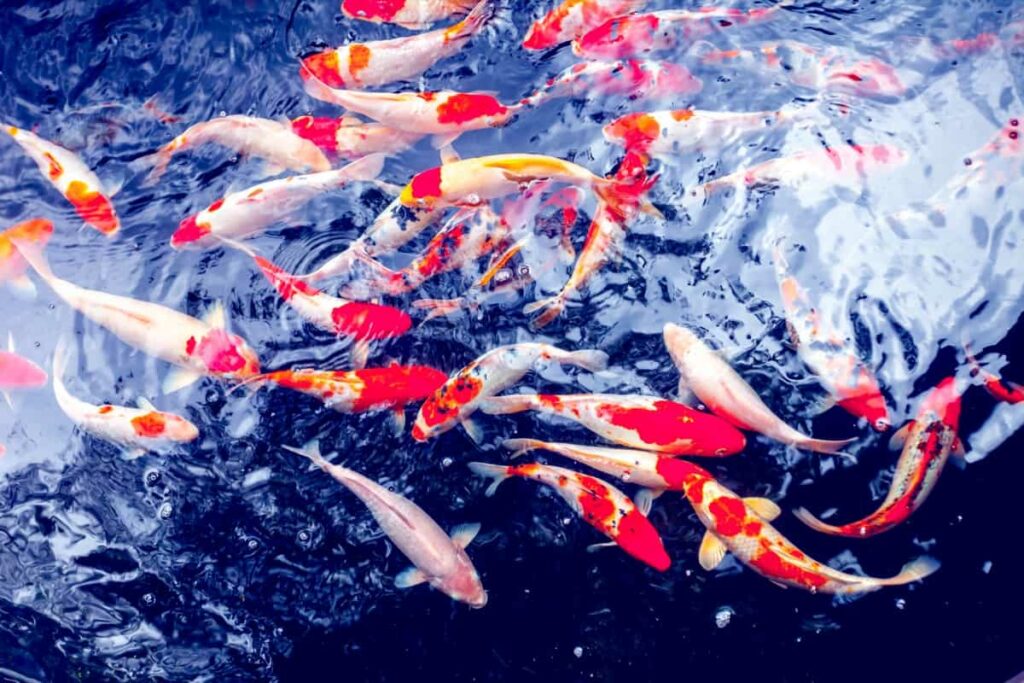
Koi Fish Farming Techniques in the Philippines
- Pond Design and Setup: Begin with a spacious pond, about 10 feet long and six feet deep, offering ample room for koi to thrive. Incorporate efficient filtration and aeration systems to maintain optimal water quality.
- Water Management: Regularly test water parameters like pH, ammonia, and nitrite levels to ensure a healthy aquatic environment. Conduct partial water changes to prevent the buildup of harmful substances.
- Koi Selection and Breeding: Choose koi varieties suitable for local conditions, considering color, size, and patterns. Engage in selective breeding to enhance desirable traits and produce robust offspring.
- Feeding Regimen: Provide high-quality koi pellets containing essential nutrients for growth and vibrant coloration. Avoid overfeeding to prevent water pollution and obesity among Koi.
- Health Monitoring: Regularly inspect Koi for signs of illness or parasites, addressing issues promptly. Quarantine new koi additions to prevent the introduction of diseases.
- Temperature Control: Maintaining stable water temperature, ideally between 70 to 75°F, promotes koi health and growth. Consider using heaters or shading to regulate temperature variations.
- Harvesting and Selling: Harvest matures Koi based on size and market demand. Market koi for ornamental purposes or as food, adhering to local regulations.
Starting a Koi Fish Farm in the Philippines
- Ideal Location: Choose a sunny spot, ensuring at least 6 hours of sunlight daily. Opt for a level area to prevent future complications.
- Excavation: Dig a hole approximately 2 feet deep and 10 feet wide. Clear rocks and roots to ensure a smooth foundation.
- Lining the Pond: Line the hole with rubber or concrete to prevent leaks and facilitate cleaning. Smooth concrete edges to prevent harm to Koi.
- Water Filling: Fill the pond gradually, monitoring for any irregularities.
- Filtration and Aeration: Install a reliable filtration and aeration system for water quality maintenance.
- Introducing Koi: gradually, Acclimate koi to the pond to prevent shock. Ensure proper quarantine for new additions.
- Feeding: Choose high-quality feeds containing animal-based proteins like shrimp and worms. Feed Koi two to three times daily, considering age and activity level. Koi’s omnivorous nature dictates a mix of plant and animal-based foods. Prioritize feeds rich in animal proteins like shrimp and crabs. Opt for pellet or flake sizes suitable for your Koi’s size. Feed them twice to thrice daily, varying age and activity level.
Koi Fish Varieties Suitable for Farming in the Philippines
Several Koi fish varieties in the Philippines are well-suited for farming due to their adaptability and visual appeal. Common types include Kohaku, Sanke, and Showa, known for their vibrant red, white, and black patterns. The Yamabuki Ogon, with its metallic yellow hue, thrives in local conditions.
In case you missed it: Goldfish Farming in the Philippines: How to Farm Goldfish for Profit
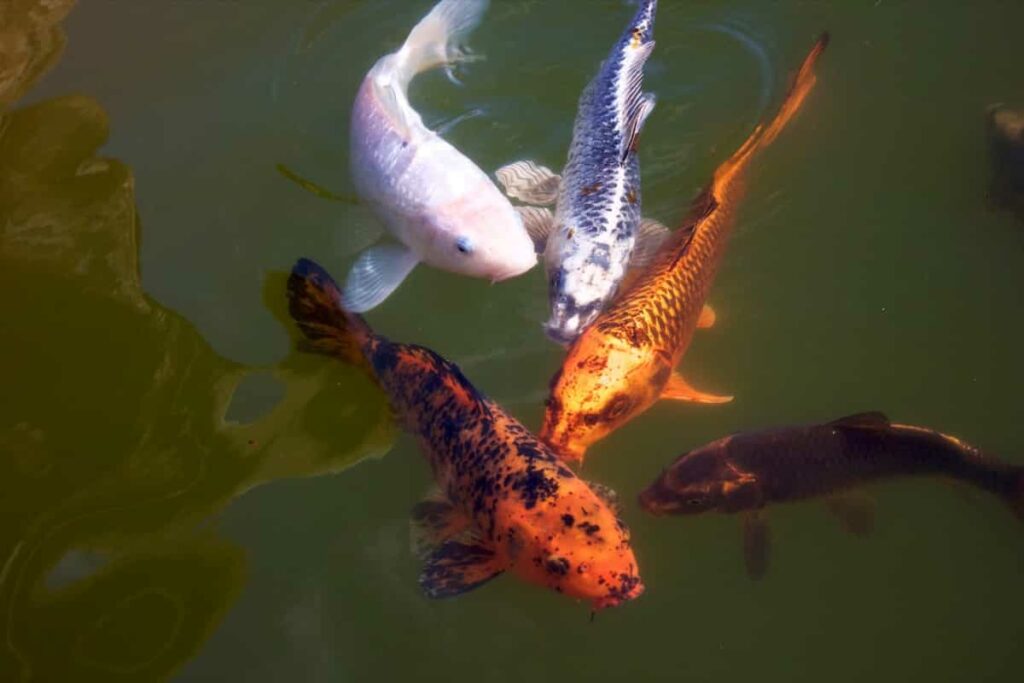
With its blue-gray coloration and distinctive reticulated pattern, Asagi finds a place. Additionally, the Bekko, showcasing a white, red, or yellow body with black markings, and the sleek Shusui, displaying bluish scales along its dorsal ridge, are favored options, complementing the tropical landscape while thriving in Philippine waters.
Feeding and Nutrition for Koi Fish Farming in the Philippines
Koi fish farming in the Philippines is crucial for their growth and aesthetics. After successful breeding, nourishing the Koi with hatched brine shrimp is essential for their lustrous skin and scales. Feeding Koi requires approximately 40% protein content for optimal growth, and proper feeding practices align with successful culling.
Understanding Koi’s evolving protein needs is essential, with higher intake during the early stages and moderation during winter due to slowed metabolism in colder water. Feeding Koi up to four times daily, with each session lasting around five minutes, is recommended. Koi are versatile eaters, enjoying bugs, insects, plants, algae, and human food like rice, cereal, lettuce, peas, and watermelon.
Water Quality Management in Koi Fish Farming in the Philippines
In Koi fish farming within the Philippines, effective water quality management is imperative for thriving aquatic ecosystems. Maintaining optimal water conditions ensures the well-being of the Koi and their environment. Regular monitoring of parameters like pH, ammonia, nitrite, and dissolved oxygen levels is essential.
Adequate filtration systems, encompassing mechanical and biological components, help remove debris and maintain water clarity. Aeration aids in oxygen exchange, which is vital for Koi’s health. Routine water changes prevent the accumulation of pollutants and maintain overall water quality. Striking a balance between these factors is critical for promoting growth, coloration, and longevity in Koi fish.
Disease Prevention and Control in Koi Fish Farming in the Philippines
Koi fish farming in the Philippines is crucial for maintaining healthy stocks due to the vulnerability of the fish to diseases such as koi herpes virus, koi pox, and bacterial infections. KHV is the most severe disease, requiring strict measures like quarantining and maintaining water quality. Koi pox, a viral disease, can cause white lesions on fish skin and can damage the fish’s appearance.
Bacterial infections, often triggered by stress or open wounds, require antibiotic treatment. Regular observation and swift intervention are essential for maintaining a thriving and disease-free environment. Incorporating rigorous disease management strategies, such as quarantine practices and proactive medication, is essential for the well-being of the Koi fish population.
Market Demand and Profitability of Koi Fish Farming in the Philippines
Koi fish farming in the Philippines has promising prospects due to its market demand and profitability. Depending on quality, selling Koi fish can yield substantial profits, ranging from P2,500 to P5,000 for regular carp and up to P150,000 to P200,000 or more for champion-grade Koi. The market thrives due to its aesthetic appeal and cultural significance, and breeding and selling Koi can generate considerable revenue.
Koi fish’s vibrant colors and unique patterns make them desirable among collectors and enthusiasts. The profitability of Koi farming depends on efficient management practices, including pond setup, water quality maintenance, and disease prevention. A well-executed business plan and market trends can maximize returns, but challenges like disease outbreaks, fluctuating demand, and operational costs must be addressed for long-term profitability.
Koi Fish Breeding Methods for Philippine Farmers
Successful Koi fish breeding methods for Philippine farmers necessitate meticulous attention to breeding stock. Opt for orange or red Koi, which yield higher returns as they grow. Bigger Koi command greater value, with Sansai maturing for sale in three years, surpassing Nisai’s two-year growth. High-quality breeding stock ensures healthy offspring. Select breeders aged three or older for optimal results. Begin with two or three quality Koi, breeding them to establish a stock. Isolate new additions to prevent mixing with larger Koi.
In case you missed it: Cavendish Banana Farming in the Philippines: Cultivation Practices
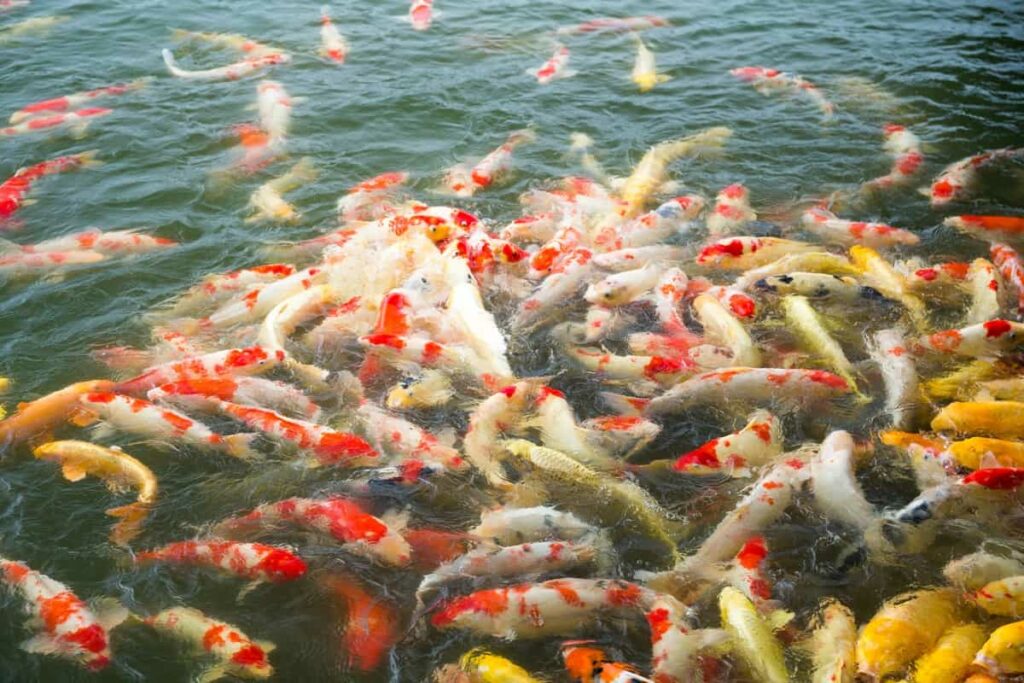
Koi Fish Pond Construction and Design for Philippine Farms
Constructing and designing Koi fish ponds for Philippine farms requires thoughtful planning. The optimal pond size is over 1,000 gallons, at least three feet deep. Select a sunny location with level ground. Begin by excavating a hole about 2 feet deep and 10 feet wide, considering potential obstacles. Line the hole with rubber or concrete for leak prevention. Gradually fill the pond with water, ensuring proper filtration and aeration systems. Maintain stable water parameters and facilitate quarantine for new Koi.
Harvesting and Selling Koi Fish in the Philippine Market
Culling: As Koi lay eggs, culling or selection becomes vital, as not all eggs hatch. Discern visually appealing fish from those less desirable for the market. Removing unattractive fish promptly is essential for business viability.
Selling: The final step involves selling mature Koi, culminating your efforts. Building a reputation as a quality producer takes time, but diligent work and effective marketing yield profits. Established companies can sell 20,000 to 30,000 fish yearly, with prices ranging from $15 to $5,000 per Koi.
Marketing: Showcase Koi with high-quality photos on social media or dedicated websites. Focusing on common varieties like Sanke, Kohaku, Showa, and Shusui can yield profitable returns.
Exporting Koi Fish From the Philippines
Exporting Koi fish from the Philippines presents a lucrative opportunity. With its diverse Koi varieties and growing market demand, the country can cater to international enthusiasts and collectors. To succeed, farmers should focus on breeding high-quality Koi, adhering to international regulations, and establishing reliable distribution networks.
In case you missed it: How to Start Shrimp Farming in the Philippines: At Home, Indoors, Backyard, Pond Culture, Shrimp Types, Cost, Profits, and Guide for Vannamei
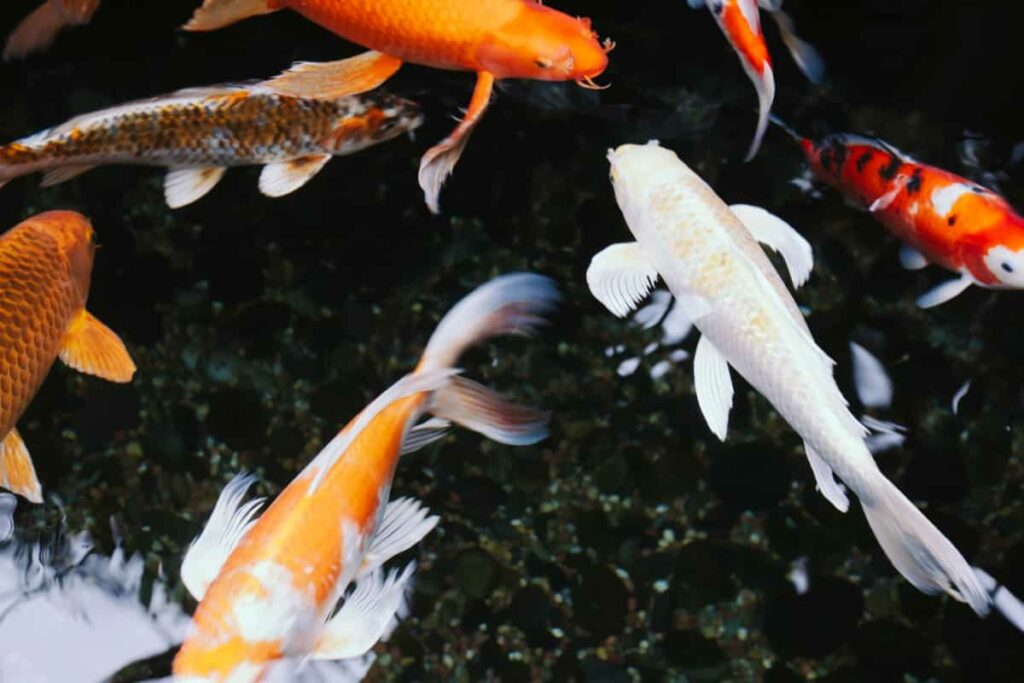
Conclusion
In the Philippines, Koi fish farming emerges as a profitable venture blending beauty and economics. By combining meticulous breeding, proper pond design, attentive care, and strategic marketing, farmers can tap into the growing market demand for these ornamental fish. With dedication, Koi farming promises both aesthetic satisfaction and financial rewards.
- Profitable Village Farming Business Ideas in 2024
- High-Yield Aquaculture: Fast-Growing Fish for Farming
- Effective Fish Pond Construction Techniques for Beginners
- Irrigation and Water Management in Pineapple Farming
- Blossom to Harvest: Mastering Flowering and Pollination in Papaya Farming
- Pig Fattening Essentials: From Selection to Sale for Beginners
- Raising Wagyu Cattle: A Complete Guide for Premium Beef Production
- Soil Types and Their Water Holding Capacity
- Optimizing Irrigation Schedules for Coconut Groves for Enhanced Yield
- Espresso Your Garden: Coffee Grounds for Healthier Acid-Loving Plants
- The Best Soil Mix for Snake Plants: How to Mix Your Own Snake Plant Soil
- Green Thumb Success: Expert Tips for Cultivating Greenhouse Beans All Year Round
- Bloom All Year Round: The Ultimate Guide to Indoor Hyacinth Care
- Eco-Friendly Gardening: How to Make Liquid Fertilizer from Kitchen Waste
- Ultimate Guide to Grow Anise in Pots: Explore Seed Propagation to Harvesting
- Guide to Raising Chester White Pigs: Discover Breed Facts to Growth Management
- Mastering the Elegance: The Ultimate Guide to Weeping Cherry Tree Care, Planting, and Maintenance
- Ultimate Guide to Planting Garlic in Grow Bags: Growing Strategies for Beginners
- How to Fix Spider Plant Leaf-Related Problems: Natural and Organic Remedies
- 10 Reasons Why Your Tulsi Plant is Shedding Leaves: Home Remedies and Solutions
- Optimizing Growth and Yield: The Advantages of Palm Bunch Ash Fertilizer
- Utilizing Neem Oil Extract as a Natural Pesticide for Hydrangea
- From Soil to Harvest: Various Ways in Which Farmers Can Use AI Tools
- Steps to Encourage and Induce Citrus Flowers: A Comprehensive Guide
- How to Fix Snake Plant Leaf-Related Issues: Natural and Organic Remedies
- Transform Your Garden into a Fragrant Oasis with Raat Ki Rani (Night Blooming Jasmine)
- Discover the Ideal Chicken Breeds for Philippine Farms
- How to Create a Poultry Egg Farm Business Plan for Profits
- Grow Lemon Cucumbers Like a Pro: Insider Techniques for Bountiful Yields
- Ultimate Guide to Caring for Your Pink Princess Philodendron: Tips for Thriving Variegation
- Areca Nut Profit Per Acre: Calculating Yield and Cost of Cultivation
- How Kaveri Chicken is Becoming a More Profitable Breed in Indian Backyards
- Transform Your Barn: 9 Steps to Convert a Horse Stall into a Chicken Coop
- Exploring Suffolk Sheep Disadvantages with Limitations and Challenges
- Guide to Solving Potted Lemon Tree Problems: How to Revive Lemon Tree in Containers
- Steps to Encourage Female Pumpkin Flowers: Best Strategies for More Flowers and High Yields
